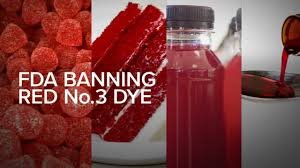
Due to a link to cancer, the FDA has finally banned Red Dye No. 3 from foods, beverages, and medications in the US.
Photo Credit ( Freepik )
Due to a link to cancer, the FDA has finally banned Red Dye No. 3 from foods, beverages, and medications in the US.
This week, the Food and Drug Administration made the long-awaited announcement that it will outlaw the use of Red Dye No. 3 (RD3) in food. It must be removed by 2027 for food industries and 2028 for pharmaceutical companies.Following years of lobbying by groups citing data demonstrating that RD3 has caused cancer in animals, the decision was made. Since 1990, it has been prohibited in cosmetics, but it is still present in thousands of food and drink items.
The risks associated with this artificial food dye are further highlighted by recent studies. According to a 2021 study by California’s Office of Environmental Health Hazard Assessment, synthetic dyes like RD3 are associated with a higher risk of behavioural issues in kids, such as memory and attention span issues.
In a statement commemorating the announcement, Ken Cook, president and co-founder of the Environmental Working Group (EWG), said, “Without the unwavering leadership of public health advocates like Michael Jacobson and others who took up this fight decades ago on behalf of consumers, we wouldn’t be celebrating this historic decision today.”
Studies have shown that RD3 causes cancer in animals, making it a particularly dangerous food dye. Although synthetic food colours are not prohibited in Europe, manufacturers must include warning warnings about the risks on the package, just like with cigarettes. In fact, the majority of products use carotenoids for red and orange, curcumin for yellow, and spirulina for blue.
“The FDA’s action today is a huge win for consumer safety and health,” Cook added. “Despite mounting evidence that Red 3 is linked to health issues, especially in children, it was still present in food products for years.”
ANOTHER LONG-OVERDUE REGULATION: The United States Announces First-Ever Drinking Water “Forever Chemical Removal” Regulations
“This ban sends a strong message that the limited interests of the food industry must always be subordinated to the protection of Americans’ health, especially that of vulnerable children.”
Food Chemicals: US Appeals Court Declares EPA’s Human Antibiotic Approval as a Citrus Pesticide Illegal
When GNN last reported on food colourings, Yellow Dye No. 5, also known as tartrazine, which is derived from coal processing, was under regulatory scrutiny for its potential to affect children’s hyperactivity. Although YD5 has been linked to numerous illnesses, such as cancer, asthma, and ADD/ADHD, it is nevertheless permitted for use as a food additive.
This week, the Food and Drug Administration made the long-awaited announcement that it will outlaw the use of Red Dye No. 3 (RD3) in food. It must be removed by 2027 for food industries and 2028 for pharmaceutical companies.Following years of lobbying by groups citing data demonstrating that RD3 has caused cancer in animals, the decision was made. Since 1990, it has been prohibited in cosmetics, but it is still present in thousands of food and drink items.
The risks associated with this artificial food dye are further highlighted by recent studies. According to a 2021 study by California’s Office of Environmental Health Hazard Assessment, synthetic dyes like RD3 are associated with a higher risk of behavioural issues in kids, such as memory and attention span issues.
In a statement commemorating the announcement, Ken Cook, president and co-founder of the Environmental Working Group (EWG), said, “Without the unwavering leadership of public health advocates like Michael Jacobson and others who took up this fight decades ago on behalf of consumers, we wouldn’t be celebrating this historic decision today.”
Studies have shown that RD3 causes cancer in animals, making it a particularly dangerous food dye. Although synthetic food colours are not prohibited in Europe, manufacturers must include warning warnings about the risks on the package, just like with cigarettes. In fact, the majority of products use carotenoids for red and orange, curcumin for yellow, and spirulina for blue.
“The FDA’s action today is a huge win for consumer safety and health,” Cook added. “Despite mounting evidence that Red 3 is linked to health issues, especially in children, it was still present in food products for years.”
ANOTHER LONG-OVERDUE REGULATION: The United States Announces First-Ever Drinking Water “Forever Chemical Removal” Regulations
“This ban sends a strong message that the limited interests of the food industry must always be subordinated to the protection of Americans’ health, especially that of vulnerable children.”
Food Chemicals: US Appeals Court Declares EPA’s Human Antibiotic Approval as a Citrus Pesticide Illegal
When GNN last reported on food colourings, Yellow Dye No. 5, also known as tartrazine, which is derived from coal processing, was under regulatory scrutiny for its potential to affect children’s hyperactivity. Although YD5 has been linked to numerous illnesses, such as cancer, asthma, and ADD/ADHD, it is nevertheless permitted for use as a food additive.


